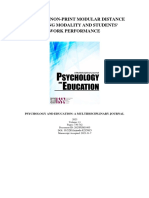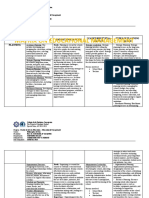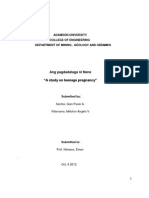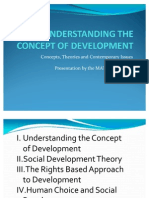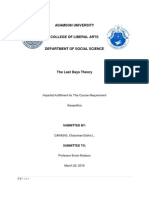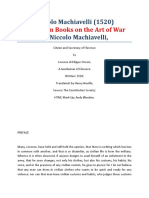Sasi Enriquez
Sasi Enriquez
Uploaded by
Eman NolascoCopyright:
Available Formats
Sasi Enriquez
Sasi Enriquez
Uploaded by
Eman NolascoCopyright
Available Formats
Share this document
Did you find this document useful?
Is this content inappropriate?
Copyright:
Available Formats
Sasi Enriquez
Sasi Enriquez
Uploaded by
Eman NolascoCopyright:
Available Formats
ADAMSON UNIVERSITY COLLEGE OF ENGINEERING Department of Electronics Engineering
The K to 12 Basic Education Program:
SOLUTION TO THE PROBLEM OR JUST ANOTHER PROBLEM?
Submitted By: Enriquez, John Paulo M. Sasi, Krysha Mae Collin J.
Submitted To: Prof. Eman Nolasco October 10, 2012
Introduction We need to add two years to our basic education. Those who can afford pay up to fourteen years of schooling before university. Thus their children are getting into the best Universities and the best jobs after graduation. I want at least 12 years for our public school children to give them an even chance at succeeding. -- President Benigno S. Aquino III Spending six years in the elementary level, four years in high school, and four years in college is quite enough for a student to learn. But for others, the more time spent in studying, the more learning a student can acquire. Our country have been dreaming for a long time to have a high quality education and this dream was finally achieved as the Department of Education newly proposed law K to 12 Basic Education Program was successfully implemented in the Philippines which was started on the School Year 2012-2013 with Grade 1 and Grade 7 students. K to 12 Program includes Kindergarten, six years of Elementary (Grade 1 6), four years of Junior High School (Grade 7 10) and two years of Senior High School (Grade 11 12). The recent graduates in Grade 6 will be the first batch to graduate as junior high school in 2016. The program will not affect the students who are incoming second year, third year and fourth year. Filipino children aged five years-old are now necessary to spend two years in kindergarten before entering Grade 1. The Philippines is considered to be the only country in Asia and is one of only three countries in the world with a ten-year basic education curriculum, the rest is under the twelve year education curriculum or also known as K to 12. Some countries who are under the K to 12 are the well-developed countries like USA, Canada, Australia, China and others which really reached competitive advantage and stable economy for the past years and continuously doing so. So the government concluded that if we will use the same program, we can also achieve what the other countries achieved. This is one of the programs under the Aquino Administration which aims for the enhancement of the quality of the basic education in the Philippines. The program also intends to boost up the quality education in the Philippines so that many high school graduates even though they havent gone to college, they can easily be employed in some particular jobs. But not everyone was in favor of this program and do not agrees that the additional years will result in well-educated, excellent, and globally competitive graduates. The K to 12 Program is a very good idea but there are still some problems that the government needed to solve for this program to be successful in its endeavor.
Discussion The Department of Education blames the low performance of Filipino students on the previous Education system, they said that the previous curriculum is designed for 12 years of teaching yet it is delivered in just 10 years thats why they implemented the current Education system which is the K to 12 Program. The Department of Education stressed that K to 12 Program aims to uplift the quality of education that will fully enhance and develop the students in order for them to be well-prepared and will help students to be able to get sufficient instructional time or time to do a subject-related task which makes them more prepared and well-trained on a particular subject and also to help the graduates of this program to be more prepared to enter the labor force and to be easily employed as well. Every graduate of the Enhanced K to 12 Program is an empowered individual who has learned through a program that is embedded on good educational principles and geared towards excellence, the foundations for learning throughout life, the competence to engage in work and be productive, the ability to coexist in productive agreement with local and global communities, the capability to engage in independent critical thinking, and the capacity to transform others and ones self. K to 12 Program offers a more balanced and advanced approach to learning that will allow children to obtain and master lifetime learning skills and it will help in releasing parents of the burden of having to spend a lot of money for college just to make their children employable. K to 12 will assist an accelerated economic growth and will facilitate common acknowledgment of Filipino graduates and professionals in other countries. This program will benefits those families who cannot pay for a college but still wish to have their children get a high-quality job because this will be a minus 2 instead of plus 2 education. On the previous Education system, parents spend for at least 4 years of college to have an employable child. In the newly enhanced Education system, parents can no longer pay for 2 years of basic education that will give them an employable child. In effect, we are saving parents 2 years of expenses. The plan is not Plus 2 years before graduation but Minus 2 years before work. On the other hand, the additional 2 years of this program or the Senior High School will be in-depth specialization for students depending on the occupation/career track they wish to pursue. It intends to provide time for students to combine acquired academic skills and competencies. The curriculum will include specializations in Science and Technology, Music and Arts, Agriculture and Fisheries, Sports, Business and Entrepreneurship. With this new
curriculum, it will enhance and be more focus to allow mastery of learning of the students and those Senior High School students can choose a field in which they are good at and they are interested in so they can be equipped and prepared with the skills needed for a specific job even without a college degree, the areas of specialization will be offered according to the resources available in a locality and the needs of students. Approximately at the age of 18, the age they will graduate from high school, they will be employable and competitive already. The graduates of this program will easily be employed because DepEd has entered into an agreement with business organizations and local and foreign chambers of commerce and industries that the graduates under the K to 12 Program will be considered for employment. There will be a matching of competency requirements and standards so that 12-year basic education graduates will have the necessary skills needed by the labor market. Entrepreneurship will also be fostered in the enhanced curriculum; ensuring graduates can venture into other opportunities beyond employment. The K to 12 Program will also help working students, they will be given a consideration in attending their classes. DepEd is in collaboration with the Commission on Higher Education (CHED) to provide more opportunities for working students to attend classes. DepEd is also working with the Department of Labor and Employment (DOLE) to ensure that jobs will be available to K to 12 graduates and that consideration will be given to working students. Having the K to 12 Program to be implemented here in the Philippines would make every student not only to be excellent in their work but also to be skillful and well-prepared for their work. A 12-year program is found to be the adequate period for learning under basic education. It is also a standard for recognition of students and/or professional abroad. However, there are lots of things to be considered first and there are still some problems that the government needs to resolve before they can successfully implement the plan. The proposed program is good but it still won't work if the needed elements to make it work arent present. If the Filipino community will be under the program, some inconsistencies will occur for sure, the primary problem is the financial capability of parents to send their children to school, in the present setting, a lot of children are out of school, simply because they cannot afford education, how much more an additional 2 years. In fact, there are already a lot of problems at the current 10-year Education system and it has nothing to do with number of years. Starting with the lack of classrooms and schools to comfortably fit all the students and there are not enough books. Plus the problem of poor quality books, on top of that there are not enough
facilities and services and finally very high drop out rates. The latter, high drop out rates is being cause by somewhat out of the education system but affects a large part of the population poverty. There are just a lot of poor families and they are so poor that many of them cannot afford to pay for the already small quantity needed for the education of their children. There are also not enough eligible teachers to educate all the students. That is made worst with just too much students. Grade school and high school are free in public schools with parents needing to just spend on uniforms, fare and some expenses. The tuition which usually accounts for a very large share of the total expenses are free and yet most poor families can still not afford of what is left for them to spend. It is not that the costs are high, its just their income is very low. It is this inability to afford the other expenses that has caused a very high drop out rate among students. This plan of the DepEd to add two more years will of course not solve any of the above problems. In fact, it will only extend all those problems by two more years. A longer basic education will also mean even higher drop out rates. Then there is the problem of additional expenses for the government. There is already concerned lack of classrooms and schools with the 10-year curriculum. The public schools cannot turn the students away when they show up to enroll. To cope many public schools have crammed as many students as they can pack together inside the classroom with classrooms compressed with chairs from wall to wall. Not enough, the schools conduct classes in at least shifts, in some case classes held very early in the morning till late in the evening. Apparently, with two additional years, the schools will
definitely need to construct new buildings and classrooms. Kindergarten, six years of primary education, four years in junior high school and two years in senior high school will provide enough time for the students to master concepts and skills that they can use as they enter college. Take for example, a college student who shifts from one course to another not because of failing major subjects, not because of parents choice, but because the course doesnt suits the students interest anymore and found out that he really do not like the course. That is clearly a waste of time, money and energy. Students under K+12 programs will be given a lot time to think about what they really want to do because there will be a lot of orientations, mastery of skills and concepts and they will be a lot more than prepared for tertiary level of education.
Based on the survey that we have conducted, when it comes to adults, most of them are in favored of this program. But when it comes to some teenagers, the majority is not in favored of this program. They said that this program was just a waste of time and money and they are too lazy to go to school and study with additional 2 years in high school plus college. They reasoned out that if you come to think of it, the people of our government like our president, vice-president, senators etc. even the successful Filipino nurses, engineers, architects etc. was not part of the K to 12 Program but a beneficiary of the 10-year program and indeed excel and recognized not only in our country, but also around the world. They said that the Philippines is the last country in Asia and one of only three countries worldwide with a 10-year pre-university cycle. But why do we have to follow what the rest of the world is doing? We are better than all of them. Filipinos right now are accepted in prestigious graduate schools in the world, even with only ten years of basic education. But what is difficult to comprehend is the complaint that K-12 is an elitist measure to align our system to those of developed countries and make it easier for wealthy students to gain admission to their schools. These students will indeed benefit from the program. But even developing countries have invested in additional years of basic education. In the Philippines, the best private schools require 11 years of basic education, against the 10 years in public schools. K-12 will help level the playing field for those who cannot afford the elite schools. Conclusion Apparently, the Philippines is not yet ready and prepared enough for K to 12 Program. The usefulness of K to 12 may be just another subject of debate, yet even if we think that it is a sound system, the existing condition of the Education Sector makes the K to 12 unreasonable. Try to put ourselves in our parents place, would we exchange our blood and sweat to some mediocre education? Most people have said that implementing K to 12 is like having a planned yet unexpected baby. Wanted but on the other side not ready enough to face the consequences. It is because of schools that are lacking of classrooms, students are required to fit themselves on the accessible ones, resulting to over-crowded classes. And because schools have book shortage, students will be required to bear with the available ones, making them stand a 3:1 student to book ratio. And lastly, because schools lack excellent teachers, as a result, a large number of students have to listen on a single teacher and teachers are required to teach a large quantity of students, which is very alarming.
Adding additional years will not make up to the reality that the Philippine Public Schools are not fit for Education; adding additional years will not make up to the current insufficiency in the Education Sector; adding additional years will not make things better, itll just worsen things. The proposal of increasing the number of years and filling the gaps at the same time is very bizarre. For the first batches, it would definitely be disastrous because they will have to tolerate the current deficiencies while adapting to a new system. They are the ones who have to adjust. A government officer concluded that K to 12 Program is a very appealing bill but if you will think of all the money and efforts needed, we might not succeed at this and will just add the rate of drop out students. The familys point of view, especially the parents, regarding this is very important since the latter are the source of the students needs. However, some people still looked at it at a different point and angle and chose to look on the positive side, despite of all the negative views that try to prevent on implementing this bill. K to 12 may be the anticipated solution for the Filipino race to be able to kill poverty. There have been different promises of the K to 12 that ensure more benefits. First, unemployment will be lessen since it will allow a child to graduate at the legal age thus making him/her to be able earn a living and support his/her family without even having the need to finish a college degree. Second, it will help to enhance the students linguistic abilities because it has been declared that K to 12 focuses on the subject English, Mathematics and Science. And lastly, it will serve as a big help for those students who most likely would wish to find a job out of the country. The fate and luck of our country is in our own hands. The only questions are will we catch the once in a lifetime option that may help us lead to the road of success or just wait, kill time and find another solution that is not uncertain and risky enough for our country to be able to take? The additional 2 years in High School will never be such a burden if we will only open doors for opportunities, for this will make our country free from ignorance and uplifted from poverty and may this be a key for every Filipino Youth to make their dreams into reality. In the end, the governments capability to secure resources to implement the K to 12 Program and at the same time address the unsettled shortages in educational inputs will determine the countrys quality of education in the future. As intelligently stated in the Philippine EFA plan, Good education is expensive but lack of education costs many times more.
Recommendation The Department of Education must first fill out its gaps and deficiencies before making any major development. There are many things that are needed to be taken care of, before even trying to adopt a new system. We cant just add more problems over problems. The current Education Sector is like a boat, with many holes in it. Placing a better captain will not make-up to the fact that there are holes in the ship; what will fix the problem is repairing the holes of the ship. The problem is observable, the solution is available, and the only thing needed is action. The Department of Education can create a tasks force to detail the K to 12 implementation model in different sides of our country so many people who do not understand the purpose of this program will be lighten up and be inform about the aim of the K to 12 Program. Our government can conduct programs for enhancing and upgrading the skills and abilities of teachers. A training program is pretty much enough for teachers to gain knowledge that can help them in this newly implemented program. Our government should have financial studies regarding on the expenses that can imply in this program, if theres a budget ready to make this program successful. And they should also have curriculum review so they can have enhancement on the portion where everyone can encounter problems. When the Department of Education has already taken care of things that needs to be done and taken care of, when it has already enough books, enough teachers, enough classrooms, enough chairs and a stable budget, only then can we begin considering a new system and not until we take care of old problems, it will continue to hunt us no matter how good the new system is.
References: http://www.gov.ph/k-12/ http://www.google.com.ph/url?sa=t&rct=j&q=&esrc=s&source=web&cd=2&cad=rja&sqi=2&ved=0CC0Q FjAB&url=http%3A%2F%2Fwww.depedregion6.ph%2Fpdf%2FThe_Enhamced_%2520Kto12_Basic_Educa tion_Program.pdf&ei=twhxUKy5FM-gmQXwj4CQAQ&usg=AFQjCNE8fsTIO-eFqyvxB0tcFjQ5aqS0Ew http://www.tumblr.com/tagged/k+to+12 http://businessmirror.com.ph/home/top-news/28941-the-k12-basic-education-program-helpingfilipino-children-adapt-to-ever-changing-world http://www.tribune.net.ph/index.php/etc/item/621-preparing-your-child-for-the-k-12-curriculum http://www.academia.edu/1525168/K12_Educational_System_in_the_Philippines_-_A_Policy_Paper http://www.senate.gov.ph/publications/PB%202011-02%20%20K%20to%2012%20The%20Key%20to%20Quality.pdf http://www.interaksyon.com/article/33727/ready-or-not-k-to-12-curriculum-starts http://www.thepoc.net/thepoc-features/politi-ko/politiko-opinions/16071-k12-program.html http://www.deped.gov.ph/ http://www.sunstar.com.ph/breaking-news/2012/06/06/k-12-needed-make-filipinos-globallycompetitive-senator-says-225453 http://www.tempo.com.ph/2012/05/k12-basic-education-program-launched/ http://newsinfo.inquirer.net/214235/majority-of-filipinos-support-k-to-12-education-program-swssurvey http://www.mb.com.ph/articles/368621/tesda-to-play-key-role-in-k-to-12-program
You might also like
- Semi-Detailed Lesson Plan For Philippine Money: COinsDocument4 pagesSemi-Detailed Lesson Plan For Philippine Money: COinsRodessa Marie Canillas Lpt76% (21)
- Ubd AnimalsDocument4 pagesUbd AnimalsKathlene Joyce LacorteNo ratings yet
- The Arts and The Creation of Mind Elliot EisnerDocument5 pagesThe Arts and The Creation of Mind Elliot Eisnerapi-249781471No ratings yet
- Anecdotes and Afterthoughts - Literature As A Teacher's Curriculum PDFDocument227 pagesAnecdotes and Afterthoughts - Literature As A Teacher's Curriculum PDFhongkyhongkyNo ratings yet
- Action Research Bsed E4b PinedaDocument12 pagesAction Research Bsed E4b PinedaMa. Adelfa Apipi100% (1)
- Training Design Streamlining The Delivery of Basic Educ in The New NormalDocument7 pagesTraining Design Streamlining The Delivery of Basic Educ in The New NormalGilbert Gojoco100% (1)
- Technology-Based Teaching Practices, Teachers' Competence and Work ValuesDocument14 pagesTechnology-Based Teaching Practices, Teachers' Competence and Work ValuesPsychology and Education: A Multidisciplinary JournalNo ratings yet
- Mother Tongue As Medium of InstructionDocument3 pagesMother Tongue As Medium of InstructionchoijinaeNo ratings yet
- Understanding The K-12 Basic Education Program - Updated 042312Document30 pagesUnderstanding The K-12 Basic Education Program - Updated 042312Affirahs NurRaijeanNo ratings yet
- Dick and Carey ModelDocument29 pagesDick and Carey Modelvanessa yganaNo ratings yet
- Characteristics of SchoolDocument6 pagesCharacteristics of SchoolSMAW NC INo ratings yet
- Competency Based CurriculumDocument1 pageCompetency Based Curriculumprudence ivotu100% (1)
- Application LetterDocument5 pagesApplication LetterSamuel VillaNo ratings yet
- Be It Enacted by The Senate and The House of Representatives of The Philippines in Congress AssembledDocument12 pagesBe It Enacted by The Senate and The House of Representatives of The Philippines in Congress AssemblednivlalrakobmasNo ratings yet
- Action Research ProposalDocument8 pagesAction Research ProposalJade JuanilloNo ratings yet
- Field Study Practice Teaching Revised 2019 Final Revision As of Nov. 13 2018Document21 pagesField Study Practice Teaching Revised 2019 Final Revision As of Nov. 13 2018HoneypatNo ratings yet
- K To 12 Education ReflectionDocument1 pageK To 12 Education ReflectionJASMINE ALBOSNo ratings yet
- Modular Teaching PDFDocument3 pagesModular Teaching PDFKazumi GraceAnnNo ratings yet
- Curr DesignDocument40 pagesCurr DesignObinnaNo ratings yet
- Continuing Development (Teacher)Document18 pagesContinuing Development (Teacher)DurrahNo ratings yet
- Millicent Atkins School of Education: Common Lesson Plan TemplateDocument37 pagesMillicent Atkins School of Education: Common Lesson Plan Templateapi-444858079100% (1)
- PHD Research Creative-Humanistic-Philosophy-in-Education-PH.D-503Document65 pagesPHD Research Creative-Humanistic-Philosophy-in-Education-PH.D-503Mary Joy PagtakhanNo ratings yet
- Learning Episode 1.Document3 pagesLearning Episode 1.Anny May GusiNo ratings yet
- TEng 2 Course OutlineDocument9 pagesTEng 2 Course OutlineJudith Odfeminina100% (1)
- PPSSHDocument10 pagesPPSSHKhane AbinaNo ratings yet
- Action Research ProposalDocument7 pagesAction Research ProposalKristine BaldomaroNo ratings yet
- Teaching PhilosophyDocument4 pagesTeaching Philosophyapi-228901746No ratings yet
- Challenges, Opportunities and Work Commitment of Teachers of Learners With Special Educational Needs (LSENs) : Basis For Development ProgramDocument29 pagesChallenges, Opportunities and Work Commitment of Teachers of Learners With Special Educational Needs (LSENs) : Basis For Development ProgramPsychology and Education: A Multidisciplinary JournalNo ratings yet
- Renee Wulff - Professional ResumeDocument3 pagesRenee Wulff - Professional Resumeapi-239466453No ratings yet
- The Challenges of Modular Distance LearningDocument2 pagesThe Challenges of Modular Distance LearningMark Jerico MoralesNo ratings yet
- Article - Principals As Curriculum Leader-1Document16 pagesArticle - Principals As Curriculum Leader-1api-251474532No ratings yet
- Intro The Impact of Continuous Professional DevelopmentDocument7 pagesIntro The Impact of Continuous Professional DevelopmentAbdulAhadNo ratings yet
- Teachers and School Administrators' Perception On The Use of Standardardized Classroom Observation ToolDocument20 pagesTeachers and School Administrators' Perception On The Use of Standardardized Classroom Observation ToolInternational Journal of Innovative Science and Research TechnologyNo ratings yet
- Ra 4670Document55 pagesRa 4670JENNY ENCILA100% (1)
- Thesis Revised 4 5Document96 pagesThesis Revised 4 5Crystal Joy MalizonNo ratings yet
- SBM ChecklistDocument4 pagesSBM ChecklistWILLIEJADO LUMHODNo ratings yet
- Midterm and Final Exam Ed. 102Document8 pagesMidterm and Final Exam Ed. 102Marfe MontelibanoNo ratings yet
- Research in MTB MLEDocument5 pagesResearch in MTB MLEAnonymous SlXyTZxq5No ratings yet
- School and Community - Written ReportDocument3 pagesSchool and Community - Written Reportdave_monsantoNo ratings yet
- Science Process Skills and Proficiency Levels Among The Junior and Senior High School Science TeachersDocument6 pagesScience Process Skills and Proficiency Levels Among The Junior and Senior High School Science TeachersIOER International Multidisciplinary Research Journal ( IIMRJ)No ratings yet
- ICT For Educational ManagementDocument30 pagesICT For Educational ManagementMarvin OrbigoNo ratings yet
- Teaching StrategiesDocument16 pagesTeaching StrategiesGomonan RosannaNo ratings yet
- Action Research ProposalDocument3 pagesAction Research ProposalMaria Shiela Cantonjos MaglenteNo ratings yet
- Bullying in SchoolsDocument4 pagesBullying in Schoolsapi-225936158No ratings yet
- K-12 in The PhilippinesDocument45 pagesK-12 in The PhilippinesHELEINA MARIE PALIT-ANGNo ratings yet
- IX. Statement of Purpose of The PortfolioDocument2 pagesIX. Statement of Purpose of The PortfolioMaria Karina FerrerasNo ratings yet
- Portfolio: Results-Based Performance Management System (RPMS)Document20 pagesPortfolio: Results-Based Performance Management System (RPMS)Sheena Mae MendozaNo ratings yet
- Lesson 4 Activity 1Document2 pagesLesson 4 Activity 1Daniela Lofranco0% (1)
- Action Research in EducationDocument1 pageAction Research in EducationAiman UsmanNo ratings yet
- Print and Non-Print Modular Distance Learning Modality and Students' Work PerformanceDocument14 pagesPrint and Non-Print Modular Distance Learning Modality and Students' Work PerformancePsychology and Education: A Multidisciplinary JournalNo ratings yet
- Teachers Evaluation On K-12 CurriculumDocument97 pagesTeachers Evaluation On K-12 CurriculumChristine BantilingNo ratings yet
- Session 1. BEDP-2030Document49 pagesSession 1. BEDP-2030Jonel LambayanNo ratings yet
- Instructional Practices of Tle Teachers To The Students Satisfaction and Academic Performance of Selected Senior High Students in Laguna 1Document86 pagesInstructional Practices of Tle Teachers To The Students Satisfaction and Academic Performance of Selected Senior High Students in Laguna 1MAED-PE-PACIA, JEROMENo ratings yet
- 1 s2.0 S0738059319300471 Main PDFDocument10 pages1 s2.0 S0738059319300471 Main PDFCahyoNo ratings yet
- Intended Vs Implemented Vs Achieved CurriculumDocument14 pagesIntended Vs Implemented Vs Achieved CurriculumERICAMILES BARRIENTOSNo ratings yet
- Lifelong Learning Initiatives and Professional Development of Public Elementary School Teachers in Jomalig DistricDocument16 pagesLifelong Learning Initiatives and Professional Development of Public Elementary School Teachers in Jomalig DistricPsychology and Education: A Multidisciplinary JournalNo ratings yet
- Activity Completion Report: I. Identifying InformationDocument3 pagesActivity Completion Report: I. Identifying InformationMARIAN TIMTIMANNo ratings yet
- The Influece of School Environment On Students AchivementDocument9 pagesThe Influece of School Environment On Students AchivementEdward Clarence LimNo ratings yet
- Research Purposive CommunicationDocument6 pagesResearch Purposive CommunicationCarl AngNo ratings yet
- Research Group 3 Beed 3cDocument59 pagesResearch Group 3 Beed 3cLINDELIE CAPOYNo ratings yet
- MIDTERM-Essentials of Educational ManagementDocument5 pagesMIDTERM-Essentials of Educational ManagementChristine Joy Perion100% (1)
- Enhancing Competency of Teachers: A Teaching-And-Learning Enhancement GuideFrom EverandEnhancing Competency of Teachers: A Teaching-And-Learning Enhancement GuideNo ratings yet
- Termpaper Santos VillanuevaDocument12 pagesTermpaper Santos VillanuevaEman NolascoNo ratings yet
- Ituralde GuzaremDocument10 pagesIturalde GuzaremEman NolascoNo ratings yet
- Labaco DoctorDocument11 pagesLabaco DoctorEman NolascoNo ratings yet
- Adamson University College of Engineering Department of Electronics EngineeringDocument13 pagesAdamson University College of Engineering Department of Electronics EngineeringEman NolascoNo ratings yet
- Adamson University College of Education and Liberal Arts Department of Social SciencesDocument9 pagesAdamson University College of Education and Liberal Arts Department of Social SciencesEman NolascoNo ratings yet
- Studying Conflict TheoryDocument10 pagesStudying Conflict TheoryEman NolascoNo ratings yet
- One Ride: Thousand Ideas by Lendl Sam DamascoDocument2 pagesOne Ride: Thousand Ideas by Lendl Sam DamascoEman NolascoNo ratings yet
- Adamson University College of Education and Liberal Arts Department of Social SciencesDocument9 pagesAdamson University College of Education and Liberal Arts Department of Social SciencesEman NolascoNo ratings yet
- Understanding The Concept of DevelopmentDocument16 pagesUnderstanding The Concept of DevelopmentEman NolascoNo ratings yet
- KomunizmDocument5 pagesKomunizmEman NolascoNo ratings yet
- Term Paper CharamaeDocument12 pagesTerm Paper CharamaeEman NolascoNo ratings yet
- The Death of The AuthorDocument5 pagesThe Death of The Authorneotamizhan100% (3)
- Seven Books On The Art of WarDocument149 pagesSeven Books On The Art of WarEman NolascoNo ratings yet
- Eng 10601 32 1415b 2 PDFDocument1 pageEng 10601 32 1415b 2 PDFDileep Singh ThakurNo ratings yet
- SDFSDFSDFDocument2 pagesSDFSDFSDFapi-286058448No ratings yet
- BIA Newsletter August 2018Document8 pagesBIA Newsletter August 2018Jaak LeenknegtNo ratings yet
- Evaluatorpineda Ocampoenric Demo-Teaching-Rubric FormDocument2 pagesEvaluatorpineda Ocampoenric Demo-Teaching-Rubric Formapi-711996372No ratings yet
- SEMIDETAILEDDocument4 pagesSEMIDETAILEDElvira CuestaNo ratings yet
- Malaysian EnglishDocument6 pagesMalaysian EnglishSofinurdiyana SalehNo ratings yet
- 01 Assertiveness and Conflict Resolution Techniques EN PDFDocument5 pages01 Assertiveness and Conflict Resolution Techniques EN PDFhatisNo ratings yet
- A. Group Written Report 70%: BM007-3-1 Group L Assignment Page 1 of 4Document4 pagesA. Group Written Report 70%: BM007-3-1 Group L Assignment Page 1 of 4yoonghanNo ratings yet
- Facilitator Training: Adult & Facilitated LearningDocument16 pagesFacilitator Training: Adult & Facilitated LearningRajendra LamsalNo ratings yet
- Stiatics and Dynamics CurriculumDocument4 pagesStiatics and Dynamics CurriculumRich GarrNo ratings yet
- Application Form: Institute of Business Management & TechnologyDocument4 pagesApplication Form: Institute of Business Management & Technologyaditi_5467No ratings yet
- Concept Note - Conflict Transformation and Peace BuildingDocument4 pagesConcept Note - Conflict Transformation and Peace BuildingSubhankar ChakrabortyNo ratings yet
- Student's Perception To Teacher's Role in Blended Learning According To Felder-Soloman Index of Learning StylesDocument6 pagesStudent's Perception To Teacher's Role in Blended Learning According To Felder-Soloman Index of Learning StylesKelly LimNo ratings yet
- Pat Conway Curriculum VitaeDocument2 pagesPat Conway Curriculum Vitaeanne_conwayNo ratings yet
- ALS Solicitation LetterDocument7 pagesALS Solicitation LetterRonquillo Balonzo Salvedia100% (3)
- Lesson Plan Grammar: Prepositions Day/Date Time/ Duration Year Enrolment Unit Theme Topic Skill ObjectivesDocument3 pagesLesson Plan Grammar: Prepositions Day/Date Time/ Duration Year Enrolment Unit Theme Topic Skill ObjectivesSya SyafiayatunNo ratings yet
- The Zone of Proximal Development and Scaffolding: ZPD ExampleDocument5 pagesThe Zone of Proximal Development and Scaffolding: ZPD ExampleJABP18No ratings yet
- Final - Common Core English 10 SyllabusDocument6 pagesFinal - Common Core English 10 SyllabusChris MembribesNo ratings yet
- History Teachers Forms 1-4Document32 pagesHistory Teachers Forms 1-4ainoNo ratings yet
- XyzDocument18 pagesXyzJasbir BooraNo ratings yet
- Faa S 8081 9D Cfii PTSDocument74 pagesFaa S 8081 9D Cfii PTSDan TzurNo ratings yet
- Module 17 Teaching Older AdultsDocument15 pagesModule 17 Teaching Older AdultsMarc CapNo ratings yet
- Alysha Vergowven ResumeDocument2 pagesAlysha Vergowven Resumeapi-248263345No ratings yet
- The Art of Training (Your Animal) - Steve MartinDocument6 pagesThe Art of Training (Your Animal) - Steve MartinBlackDawnNo ratings yet
- How To Teach With Technology Like A ProDocument40 pagesHow To Teach With Technology Like A ProIsabel LizárragaNo ratings yet

















































